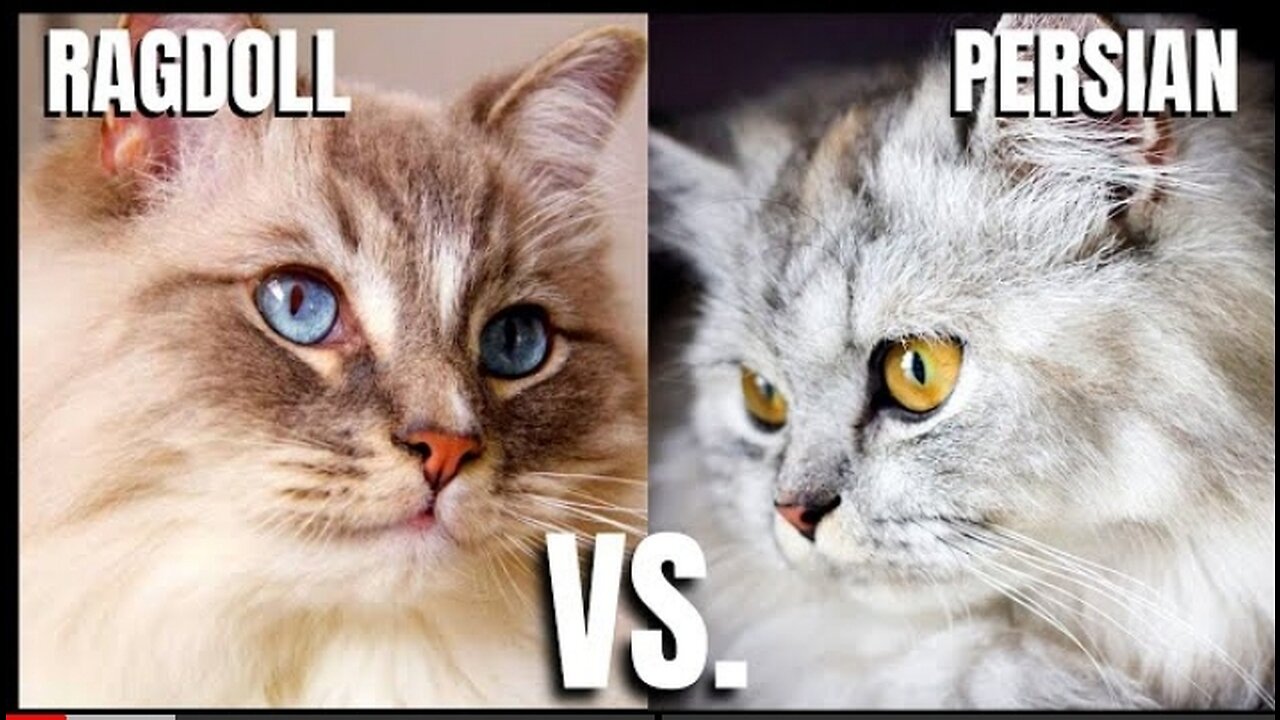Premium Only Content

Ragdoll Cat VS. Persian Cat.
Ragdoll Cat VS. Persian Cat.
What are the differences between these two cat breeds?
Ragdolls stand out for their large size, semi-long coat in a pointed pattern, and sparkling blue eyes. They are among the largest of the domesticated cats, with some males weighing in at 20 pounds or more. A Ragdoll has a light-colored body with a darker face, legs, tail, and ears. He comes in three patterns: mitted and bicolor, both of which have white, and colorpoint, which has no white. Ragdolls don’t reach their full size and coat development until they are three to four years old.
The Cat Fanciers Association breed standard says the Ragdoll should have a large, broad head in a modified wedge shape. All sides of the head should be of equal length and the muzzle should be gently rounded. The eyes are described as vivid blue ovals. Medium-size ears have rounded tips and tilt forward. Supporting the head is a heavy, strong neck, which segues into a large and long body that is broad, solid, and heavy-boned. The heavy-boned legs are moderately long, with the hind legs longer than the front legs. Large round paws are tufted with fur, and the long tail looks like a waving plume.
The Persian has a distinctive appearance: a large, round head; large, round eyes; a short nose; full cheeks; and small ears with rounded tips. The head is supported by a short, thick neck and a deceptively sturdy, muscular body—a type known as “cobby.” A Persian’s legs are short, thick, and strong with large, round, firm paws. The tail is short but proportional to the length of the cat’s body. A long, thick, shiny coat with a fine texture completes the Persian’s look. It’s long all over the body and includes an immense ruff around the neck, a deep frill between the front legs, long ear, and toe tufts, and a full “brush,” or tail.
Ragdolls are notable for collapsing into the arms of anyone who holds them, even if they are cradled on their back. They love their people, greeting them at the door, following them around the house, and leaping into a lap or snuggling in bed whenever given the chance. They often learn to come when called or to retrieve toys that are thrown for them. The word most often used to describe them is docile, but that doesn’t mean they are inactive. They like to play with toys and enter into any family activities.
The dignified and docile Persian is known for being quiet and sweet. She is an ornament to any home where she can enjoy sitting in a lap—surely her rightful place—being petted by those who are discerning enough to recognize her superior qualities, and playing house with kind children who will gently comb her hair, wheel her around in a baby buggy, then serve her tea at their parties. Persians are affectionate but discriminating. They reserve their attention for family members and those few guests whom they feel they can trust.
Loud environments aren’t a Persian’s style; they are sedate cats who prefer a serene home where little changes from day to day. With large, expressive eyes and a voice that has been described as soft, pleasant, and musical, Persians let their simple needs be known: regular meals, a little playtime with a catnip mouse or feather teaser, and lots of love, which they return tenfold.
This is one cat who is unlikely to climb up your curtains, jump on your kitchen counters, or perch on top of your refrigerator. She is perfectly happy to rule her domain from the floor or more accessible pieces of furniture. When you are at work or are busy around the house, the Persian is content to adorn a chair, sofa, or bed until you are free to admire her and give her the attention she willingly receives but never demands.
-
 LIVE
LIVE
Dr Disrespect
4 hours ago🔴LIVE - DR DISRESPECT - BATTLEFIELD 6 - CHASING 100 KILLS
1,642 watching -
 19:53
19:53
Professor Nez
38 minutes ago🚨BUSTED! JB Pritzker Just Got EXPOSED in MASSIVE Police Scandal!
3 -
 1:02:07
1:02:07
DeVory Darkins
2 hours ago $28.13 earnedDemocrats suffer MAJOR SETBACK as CNN forced to admit Trump is WINNING
96.4K39 -
 1:57:10
1:57:10
The Charlie Kirk Show
3 hours agoBoomer No Kings Commies Dream of Violence | Sav Hernandez, Cernovic, Gov. Youngkin | 10.20.2025
74.9K25 -
 LIVE
LIVE
StoneMountain64
41 minutes agoBattlefield 6 is ALREADY getting BETTER
67 watching -
 7:42
7:42
Dr. Nick Zyrowski
6 hours agoNAC ( N-Acetyl Cysteine) - The Supplement the FDA Tried to Ban (Here’s Why)
6.19K5 -
 2:03:34
2:03:34
Tucker Carlson
2 hours agoCovid Whistleblower: Predicting Pandemics & Exposing the CIA and Peter Daszak’s Alliance With China
12.9K26 -
 35:26
35:26
Sean Unpaved
3 hours agoMLB Meets CFB Chaos: Ohtani's Unicorn Night, Napier's Swamp Exit, & Bama's Rivalry Roll!
13.8K -
 LIVE
LIVE
Nerdrotic
5 hours ago $1.01 earnedOne Woke After Another Isn't WOKE According to Woke People? - Nerdrotic Nooner 527
369 watching -
 1:03:26
1:03:26
Timcast
3 hours agoSecret Service Discovers HUNTING STAND Aimed At Trump, No Kings Protests FLOP
126K103